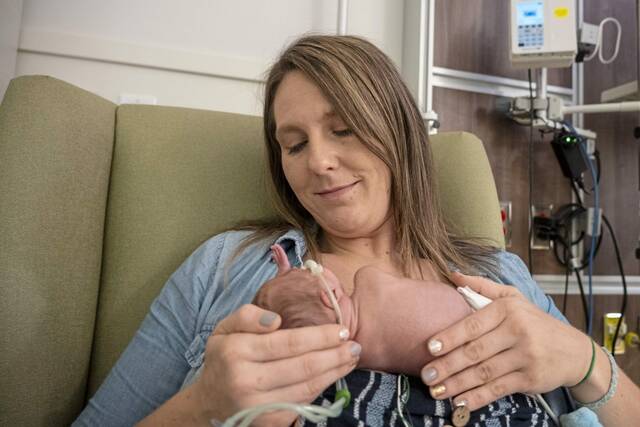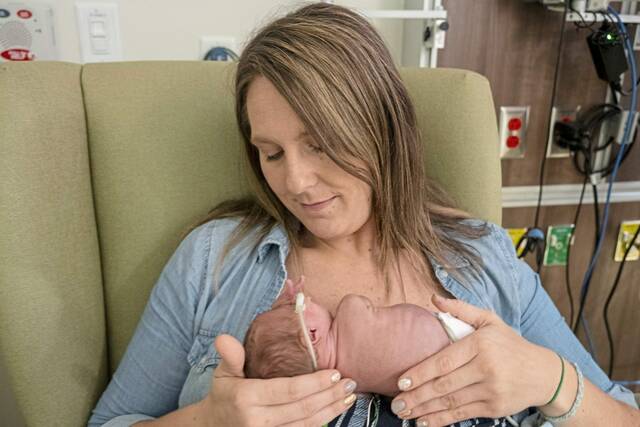Study: skin-to-skin for premature babies has positive outcomes
In a dark room, Nichole Kurtz lifts the blanket on the side of the incubator and carefully navigates the tubes and wires.
She reaches for her son, Lennox Lee-Heyward, who was born premature on July 17 at 26 weeks three days, weighing 2 pounds 4 ounces.
He lets out a soft cry as she picks him up. A nurse nearby helps Kurtz place Lennox on the top of her bare chest. He calms as he’s covered by a cloth and looks up at his mom.
The moment is called skin-to-skin.
It is contact between mother and baby – also known as kangaroo care – right after birth.
It significantly improves the odds of survival for premature or low-birth-weight babies, according to a study in the British Medical Journal.
“It was scary at first with all of the wires, and he was so little,” said Kurtz, who began skin-to-skin 72 hours after Lennox was born at Allegheny Health Network’s West Penn Hospital in Bloomfield.
Skin-to-skin resembles the practice of baby kangaroos in their mothers’ pouches. It is the act of holding baby close to parents’ bare skin – covered by a blanket or wrap – for consistent and prolonged periods of time.
The most recent analysis from the British Medical Journal looked at more than 15,000 infants worldwide and found that, compared to conventional care, kangaroo mother care seemed to reduce mortality by 32% within the first 28 days of life, especially when started immediately and for long periods of time throughout the day. It also reduced infection and rehospitalizations.
Lennox is home now.
The practice of skin-to-skin care has been around for decades but continues to grow in popularity, said Dr. William McCarran, pediatric neonatology physician for Allegheny Health Network.
Getting the parents involved in the day-to-day care is vital, McCarran said. That begins with things such as skin-to-skin, talking to the babies, reading books to them, giving them baths, helping to change their diapers and feeding them.
Kurtz pumped breast milk that was fed to Lennox, whose due date was Oct. 20.
The mother of three living children and “two in heaven” would arrive every day at 9 a.m. and stay all day at the Neonatal Intensive Care Unit at West Penn Hospital. She spent many nights there as well.
“There are ups and downs, but everyone is here to help you and your baby get through those ups and downs,” Kurtz said.
The health care workers and the other parents on the unit all form a bond, said Kurtz, 32.
“We know what this is like,” she said. “It is not supposed to happen this way, but when it does you have a place like this for your baby to grow and thrive.”
The parents create scrapbooks where they add photos and messages about their journey in the Neonatal Intensive Care Unit. There is help with meals and showers. Some of them stay there for weeks or months.
They are taught the best ways to comfort the baby and that at first, minimal stimulation is best, as the baby is still learning to transition to the outside world.
“This can be traumatic,” Kurtz said. “It taught me patience and helped me post partum. Being here, they provide the resources we need.”
Most of her skin-to-skin sessions lasted a maximum of 90 minutes. The skin-to-skin care begins once the baby is stable, usually between 48-72 hours. Moms and dads can do skin-to-skin. Some parents are fearful of touching their baby because the infant is so small and there is so much medical equipment, McCarran said.
“Skin-to-skin is a life-saving measure,” said McCarran. “We have seen dramatic improvement in babies. We make it the most positive experience for them.”
He said the babies breathe better when doing skin-to-skin. Blood pressure is lower for both baby, mom and dad. The little one can hear his parents’ heart beat.
“They are bonding,” McCarran said. “Parents play an important role in this. It is cool to watch. They become part of our medical team. As a NICU team it takes a village.”
McCarran said having parents involved is so important because the parents know the baby. It takes time to build trust with the parents, but this is a shared experience.
“It can be a roller coaster and it can be terrifying,” McCarran said. “Every baby does differently. When I see the babies months later and I see parents cry because they are happy that their baby is home and healthy that makes me overjoyed.”
The first things babies recognize is a face, McCarran said. Even though there wasn’t much light coming into that room, Kurtz looked down and smiled to make sure Lennox could see her face.
“When you are in the NICU you have to take it one-day-at-a-time,” said Kurtz, as she talked about her journey with Lennox sleeping on her chest. “In this room, there is a sense of peace and calmness. These babies are warriors. They are miracles.”
JoAnne Klimovich Harrop is a TribLive reporter covering the region's diverse culinary scene and unique homes. She writes features about interesting people. The Edward R. Murrow award-winning journalist began her career as a sports reporter. She has been with the Trib for 26 years and is the author of "A Daughter's Promise." She can be reached at jharrop@triblive.com.
Remove the ads from your TribLIVE reading experience but still support the journalists who create the content with TribLIVE Ad-Free.


